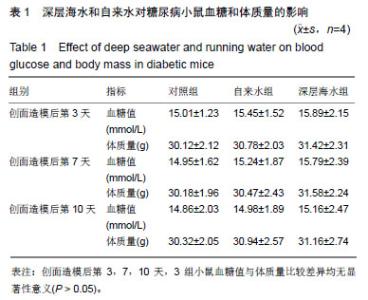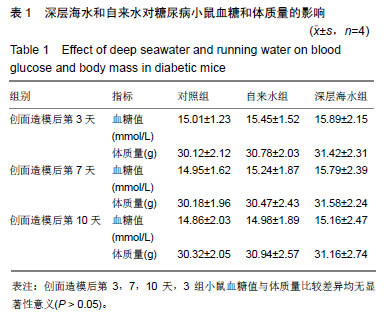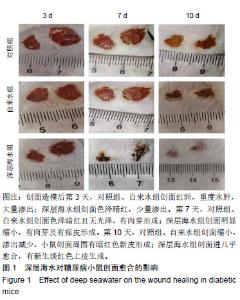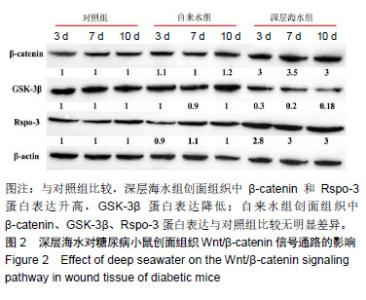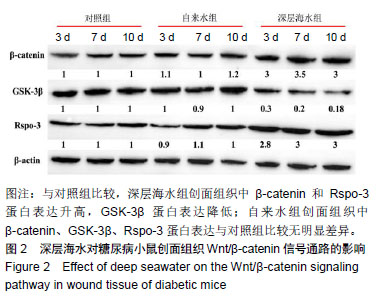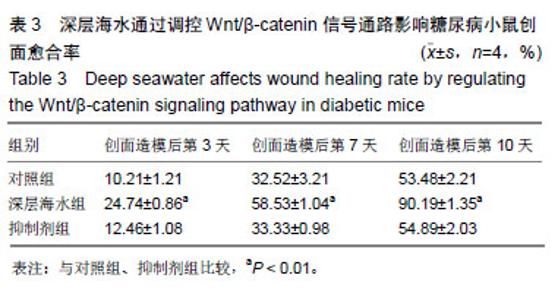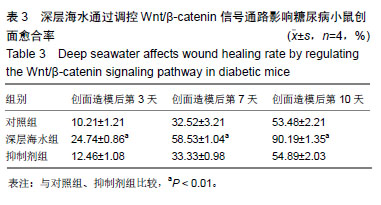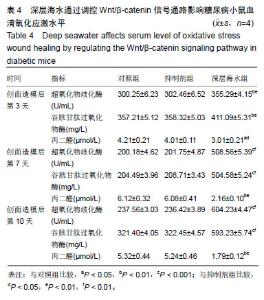Chinese Journal of Tissue Engineering Research ›› 2019, Vol. 23 ›› Issue (31): 5017-5022.doi: 10.3969/j.issn.2095-4344.1487
Previous Articles Next Articles
Deep seawater promotes cutaneous wound healing in diabetic mice via activating Wnt/β-catenin pathway
Li Weiming, Sun Dali, Li Yijun, Li Shumin, Sun Yanbo, Cui Jin, Xu Pengyuan, Xu Qingwen
- (Second Ward of Department of Gastrointestinal Surgery, the Second Affiliated Hospital of Kunming Medical University, Kunming 650101, Yunnan Province, China)
-
Received:2019-04-27Online:2019-11-08Published:2019-11-08 -
Contact:Xu Qingwen, Attending physician, Second Ward of Department of Gastrointestinal Surgery, the Second Affiliated Hospital of Kunming Medical University, Kunming 650101, Yunnan Province, China -
About author:Li Weiming, MD, Associate chief physician, Second Ward of Department of Gastrointestinal Surgery, the Second Affiliated Hospital of Kunming Medical University, Kunming 650101, Yunnan Province, China -
Supported by:the Yunnan Provincial Applied Basic Research Project, No. 2015FB057 (to LWM); the Project of Yunnan Provincial Surgical Clinical Nutrition Research Center, No. 2016NS272 (to LWM)
CLC Number:
Cite this article
Li Weiming, Sun Dali, Li Yijun, Li Shumin, Sun Yanbo, Cui Jin, Xu Pengyuan, Xu Qingwen. Deep seawater promotes cutaneous wound healing in diabetic mice via activating Wnt/β-catenin pathway [J]. Chinese Journal of Tissue Engineering Research, 2019, 23(31): 5017-5022.
share this article
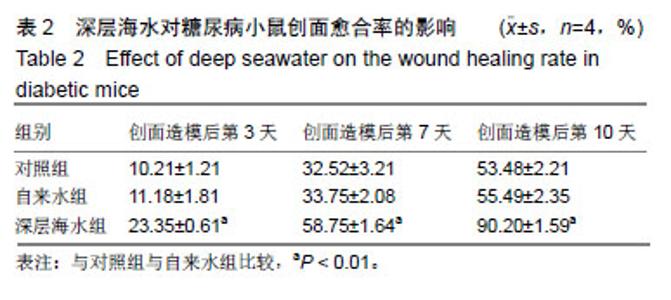
2.3 深层海水对糖尿病小鼠创面愈合的影响 该部分是阐述深层海水是否对糖尿病创面愈合有影响,抑制剂组不纳入其内。 对照组创面造模后第3天创面红润,重度水肿,大量渗出;第7天,创面色泽暗红且无光泽,有肉芽形成;第10天,创面缩小,渗出减少,小鼠创面周围有暗红色新皮形成。自来水组各个时间点的创面表现与对照组无明显差异。深层海水组创面造模后第3天创面色泽暗红,少量渗出;第7天,创面明显缩小,有肉芽形及有痂皮形成;第10天,创面进几乎愈合,有新生淡红色上皮生成,见图1。 深层海水组各时间点的创面愈合率明显高于对照组和自来水组(P < 0.01),自来水组各时间点的创面愈合率与对照组比较差异无显著性意义(P > 0.05),见表2。 "
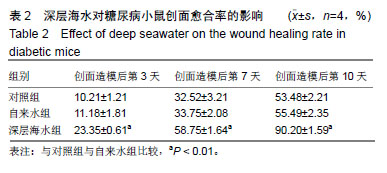
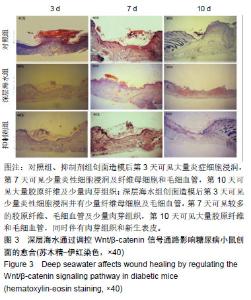
2.5 深层海水通过调控Wnt/β-catenin信号通路影响糖尿病小鼠创面的愈合 该部分实验进一步验证深层海水是否通过Wnt/β-catenin信号通路促进糖尿病小鼠创面愈合,未纳入自来水组。 2.5.1 苏木精-伊红染色结果 对照组创面造模后第3天可见大量炎症细胞浸润,第7天可见少量炎性细胞浸润及纤维母细胞和毛细血管,第10天可见大量胶原纤维及少量肉芽组织;抑制剂组各时间点病理表现与对照组相似;深层海水组创面造模后第3天可见少量炎性细胞浸润并有少量纤维母细胞及毛细血管,第7天可见较多的胶原纤维、毛细血管及少量肉芽组织,第10天可见大量胶原纤维和毛细血管,同时伴有肉芽组织和新生表皮,见图3。 "
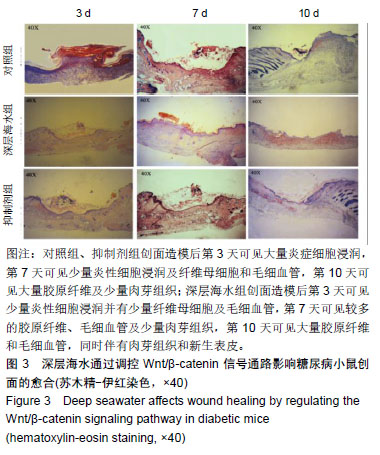
| [1]Cho H,Blatchley MR,Duh EJ,et al.Acellular and cellular approaches to improve diabetic wound healing. Adv Drug Deliv Rev.2018.pii: S0169-409X(18)30193-5.[Epub ahead of print][2]Kulprachakarn K,Ounjaijean S,Wungrath J,et al. Micronutrients and natural compounds status and their effects on wound healing in the diabetic foot ulcer.Int J Low Extrem Wounds.2017;16(4):244-250.[3]Ishihara J,Ishihara A,Starke RD,et al.The heparin binding domain of von Willebrand factor binds to growth factors and promotes angiogenesis in wound healing. Blood. 2019; pii: blood.2019000510. [Epub ahead of print][4]Liao HE,Shibu MA,Kuo WW,et al.Deep sea minerals prolong life span of streptozotocin-induced diabetic rats by compensatory augmentation of the IGF-I-survival signaling and inhibition of apoptosis. Environ Toxicol. 2016;31(7): 769-781.[5]Mohd Nani SZ,Majid FA,Jaafar AB,et al.Potential health benefits of deep sea water: a review. Evid Based Complement Alternat Med.2016;2016:6520475.[6]Schrameyer V,York PH,Chartrand K,et al.Contrasting impacts of light reduction on sediment biogeochemistry in deep- and shallow-water tropical seagrass assemblages (Green Island, Great Barrier Reef).Mar Environ Res.2018;136:38-47.[7]Hsu CL,Chang YY,Chiu CH,et al.Cardiovascular protection of deep-seawater drinking water in high-fat/cholesterol fed hamsters.Food Chem.2011;127(3):1146-1152.[8]Hsu TC,Chiu CC,Lin HL,et al.Attenuated effects of deep-sea water on hepatic apoptosis in STZ-induced diabetic rats.Chin J Physiol.2015;58(3):197-205.[9]Ha BG,Shin EJ,Park JE,et al.Anti-diabetic effect of balanced deep-sea water and its mode of action in high-fat diet induced diabetic mice. Mar Drugs.2013;11(11):4193-212.[10]陈玉姣,白晓苏,曾丽红.补气生肌方促进糖尿病性难愈创面血管新生和创面修复愈合的作用机制[J].实用药物与临床,2017, 20(10):1127-1130.[11]丁寅佳,崔磊,赵旭,等.富血小板纤维蛋白联合脂肪干细胞对糖尿病小鼠皮肤创面愈合的影响研究[J].中国美容医学, 2019,28(2): 8-13.[12]Choi SM,Lee KM,Kim HJ,et al.Effects of structurally stabilized EGF and bFGF on wound healing in type I and type II diabetic mice.Acta Biomater.2018;66:325-334.[13]Milan PB,Lotfibakhshaiesh N,Joghataie MT,et al.Accelerated wound healing in a diabetic rat model using decellularized dermal matrix and human umbilical cord perivascular cells. Acta Biomater. 2016; 45:234-246.[14]王志永,和晓培,薜欣,等.难愈性创面的发生机制及人工真皮在其治疗中的应用进展[J].临床合理用药杂志,2017,10(28): 180-181.[15]向鹏君,季晖,顾铭,等.糖尿病创面的炎症机制研究进展[J].药学研究,2017,36(11):667-670.[16]胡啸明,柳国斌.糖尿病足性溃疡愈合机制的研究进展[J].上海中医药杂志,2017,51(S1):217-219,223.[17]沈耀明.严重烧伤全身与局部微量元素含量变化特点及对创面修复的机制探讨[J].中国医药指南,2014, 12(34):117-118.[18]张文浩,吴起,马军,等.负压封闭引流联合肝素灌洗治疗兔烫伤并海水浸泡创面[J].南方医科大学学报,2015,35(10):1481-1486.[19]姚波,刘万宏,傅亚.影响创面愈合的营养因素研究进展[J].基因组学与应用生物学,2012,31(6):640-643.[20]张海峰,吕游,王洪莎,等.硫酸锌对糖尿病皮肤损伤的修复作用[J].中国老年学杂志,2016, 36(23):5777-5780.[21]李为明,崔进,徐鹏远,等.深层海水对小鼠创面愈合的促进作用[J].重庆医学,2014,43(4):462-464.[22]韩昌鹏,姜文成,李福伦,等. Wnt信号通路与创面愈合[J].中国美容医学,2012,21(7):1257-1260.[23]Tang H,Xu Y,Zhang Z,et al.SDF-1/CXCR4 induces epithelial?mesenchymal transition through activation of the Wnt/β?catenin signaling pathway in rat chronic allograft nephropathy. Mol Med Rep.2019;19(5):3696-3706.[24]Xie S,Fu W,Yu G,et al.Discovering small molecules as Wnt inhibitors that promote heart regeneration and injury repair.J Mol Cell Biol.2019.pii: mjz023. [Epub ahead of print][25]Leavitt T, Hu MS,Marshall CD, et al.Scarless wound healing: finding the right cells and signals. Cell Tissue Res. 2016; 365(3):483-493.[26]赵亚男,刘明,张玥,等.Wnt信号通路与皮肤创面愈合的关系[J].现代生物医学进展,2015,15(11):2173-2176,2184.[27]Yang HL,Tsai YC,Korivi M,et al.Lucidone promotes the cutaneous wound healing process via activation of the PI3K/AKT, Wnt/β-catenin and NF-κB signaling pathways. Biochim Biophys Acta Mol Cell Res.2017;1864(1):151-168.[28]Qi W,Yang C,Dai Z,et al.High levels of pigment epithelium-derived factor in diabetes impair wound healing through suppression of Wnt signaling. Diabetes.2015;64(4): 1407-1419.[29]Pizzute T,Li J,Zhang Y,et al.Fibroblast growth factor ligand dependent proliferation and chondrogenic differentiation of synovium-derived stem cells and concomitant adaptation of Wnt/mitogen-activated protein kinase signals.Tissue Eng Part A.2016; 22(15-16):1036-1046.[30]Hu F,Yan Y,Wang CW,et al.Article effect and mechanism of ganoderma lucidum polysaccharides on human fibroblasts and skin wound healing in mice. Chin J Integr Med. 2019; 25(3):203-209.[31]Ma T,Fu B,Yang X,et al.Adipose mesenchymal stem cell-derived exosomes promote cell proliferation, migration, and inhibit cell apoptosis via Wnt/β-catenin signaling in cutaneous wound healing. J Cell Biochem.2019;120(6): 10847-10854.[32]Zhang G,Song K,Yan H. MicroRNA-124 represses wound healing by targeting SERP1 and inhibiting the Wnt/β-catenin pathway.Adv Clin Exp Med.2019.[Epub ahead of print][33]Liu D, He S, Chen S, et al. Different effects of Wnt/β-catenin activation and Parathyroid hormone on diaphyseal and metaphyseal in the early phase of femur bone healing of mice. Clin Exp Pharmacol Physiol.2019.[Epub ahead of print][34]Bao Q,Chen S,Qin H,et al.An appropriate Wnt/β-catenin expression level during the remodeling phase is required for improved bone fracture healing in mice.Sci Rep.2017;7(1): 2695.[35]Rognoni E,Gomez C,Pisco AO,et al.Inhibition of β-catenin signalling in dermal fibroblasts enhances hair follicle regeneration during wound healing. Development.2016; 143(14):2522-2535.[36]Liu J,Wang Y,Pan Q,et al.Wnt/beta-catenin pathway forms a negative feedback loop during TGF-beta1 induced human normal skin fibroblast-to-myofibroblast transition. J Dermatol Sci. 2012; 65(1):38-49.[37]Schmid A,Sailland J,Novak L,et al.Modulation of Wnt signaling is essential for the differentiation of ciliated epithelial cells in human airways. FEBS Lett. 2017; 591(21):3493-3506. |
| [1] | Zhang Tongtong, Wang Zhonghua, Wen Jie, Song Yuxin, Liu Lin. Application of three-dimensional printing model in surgical resection and reconstruction of cervical tumor [J]. Chinese Journal of Tissue Engineering Research, 2021, 25(9): 1335-1339. |
| [2] | Shen Jinbo, Zhang Lin. Micro-injury of the Achilles tendon caused by acute exhaustive exercise in rats: ultrastructural changes and mechanism [J]. Chinese Journal of Tissue Engineering Research, 2021, 25(8): 1190-1195. |
| [3] | Tang Hui, Yao Zhihao, Luo Daowen, Peng Shuanglin, Yang Shuanglin, Wang Lang, Xiao Jingang. High fat and high sugar diet combined with streptozotocin to establish a rat model of type 2 diabetic osteoporosis [J]. Chinese Journal of Tissue Engineering Research, 2021, 25(8): 1207-1211. |
| [4] | Zeng Yanhua, Hao Yanlei. In vitro culture and purification of Schwann cells: a systematic review [J]. Chinese Journal of Tissue Engineering Research, 2021, 25(7): 1135-1141. |
| [5] | Shi Yangyang, Qin Yingfei, Wu Fuling, He Xiao, Zhang Xuejing. Pretreatment of placental mesenchymal stem cells to prevent bronchiolitis in mice [J]. Chinese Journal of Tissue Engineering Research, 2021, 25(7): 991-995. |
| [6] | Duan Liyun, Cao Xiaocang. Human placenta mesenchymal stem cells-derived extracellular vesicles regulate collagen deposition in intestinal mucosa of mice with colitis [J]. Chinese Journal of Tissue Engineering Research, 2021, 25(7): 1026-1031. |
| [7] | Wang Hanyue, Li Furong, Yang Xiaofei, Hu Chaofeng. Direct reprogramming hepatocytes into islet-like cells by efficiently targeting and activating the endogenous genes [J]. Chinese Journal of Tissue Engineering Research, 2021, 25(7): 1056-1063. |
| [8] | Xu Dongzi, Zhang Ting, Ouyang Zhaolian. The global competitive situation of cardiac tissue engineering based on patent analysis [J]. Chinese Journal of Tissue Engineering Research, 2021, 25(5): 807-812. |
| [9] | Liu Yang, Gong Yi, Fan Wei. Anti-hepatoma activity of targeted Pluronic F127/formononetin nanocomposite system in vitro [J]. Chinese Journal of Tissue Engineering Research, 2021, 25(4): 526-531. |
| [10] | Wu Zijian, Hu Zhaoduan, Xie Youqiong, Wang Feng, Li Jia, Li Bocun, Cai Guowei, Peng Rui. Three-dimensional printing technology and bone tissue engineering research: literature metrology and visual analysis of research hotspots [J]. Chinese Journal of Tissue Engineering Research, 2021, 25(4): 564-569. |
| [11] | Chang Wenliao, Zhao Jie, Sun Xiaoliang, Wang Kun, Wu Guofeng, Zhou Jian, Li Shuxiang, Sun Han. Material selection, theoretical design and biomimetic function of artificial periosteum [J]. Chinese Journal of Tissue Engineering Research, 2021, 25(4): 600-606. |
| [12] | Liu Liu, Zhou Qingzhu, Gong Zhuo, Liu Boyan, Yang Bin, Zhao Xian. Characteristics and manufacturing techniques of collagen/inorganic materials for constructing tissue-engineered bone [J]. Chinese Journal of Tissue Engineering Research, 2021, 25(4): 607-613. |
| [13] | Liu Fei, Cui Yutao, Liu He. Advantages and problems of local antibiotic delivery system in the treatment of osteomyelitis [J]. Chinese Journal of Tissue Engineering Research, 2021, 25(4): 614-620. |
| [14] | Ye Haimin, Ding Linghua, Kong Weihao, Huang Zutai, Xiong Long. Role and mechanism of hierarchical microchanneled bone scaffolds in promoting osteogenesis and angiogenesis [J]. Chinese Journal of Tissue Engineering Research, 2021, 25(4): 621-625. |
| [15] | Li Xiaozhuang, Duan Hao, Wang Weizhou, Tang Zhihong, Wang Yanghao, He Fei. Application of bone tissue engineering materials in the treatment of bone defect diseases in vivo [J]. Chinese Journal of Tissue Engineering Research, 2021, 25(4): 626-631. |
| Viewed | ||||||
|
Full text |
|
|||||
|
Abstract |
|
|||||
